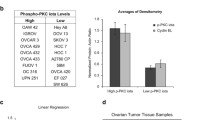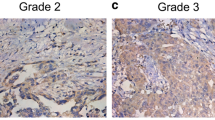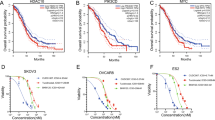Abstract
CIP2A is a recently characterized oncoprotein which involves in the progression of several human malignancies. This study aimed to investigate its clinical significance and biological function in ovarian cancer. CIP2A expression was analyzed in 152 archived ovarian cancer specimens using immunohistochemistry. One hundred cases (65.79 %) showed CIP2A overexpression, including 63 of 92 serous carcinomas (68.48 %), 21 of 33 endometrioid carcinomas (63.64 %), 12 of 23 mucinous carcinomas (52.17 %), and 4 of 4 clear cell carcinomas (100 %). There is no significant difference of CIP2A expression between serous tumors and all other morphologies combined. CIP2A overexpression positively correlated with advanced FIGO stage (p = 0.0336) and tumor grade (p = 0.0213). siRNA knockdown was performed in A2780 and SKOV3 cell lines. MTT, colony formation assay, and flow cytometry were carried out to assess the role of CIP2A in proliferation, cell cycle, and apoptosis. CIP2A depletion in ovarian cancer cell lines inhibited proliferation, blocked cell cycle progression, and increased paclitaxel-induced apoptosis. Futhermore, CIP2A depletion downregulated cyclin D1, c-myc, phospho-Rb, Bcl-2, and phospho-AKT expression. These results validate the role of CIP2A as a clinically relevant oncoprotein and establish CIP2A as a promising therapeutic target of ovarian cancer.





Similar content being viewed by others
References
Jemal A, Siegel R, Xu J, Ward E. Cancer statistics. CA Cancer J Clin. 2010;60(5):277–300.
Permuth-Wey J, Sellers TA. Epidemiology of ovarian cancer. Methods Mol Biol. 2009;472:413–37.
Darcy KM and Birrer MJ. 2010.Translational research in the Gynecologic Oncology Group: evaluation of ovarian cancer markers, profiles, and novel therapies. Gynecol Oncol. 117(3): p. 429–39.
Despierre E, Lambrechts D, Neven P, Amant F, Lambrechts S and Vergote I. 2010. The molecular genetic basis of ovarian cancer and its roadmap towards a better treatment. Gynecol Oncol. 117(2): p. 358-65
Junttila MR, Puustinen P, Niemela M, Ahola R, Arnold H, Bottzauw T, et al. CIP2A inhibits PP2A in human malignancies. Cell. 2007;130(1):51–62.
Tseng LM, Liu CY, Chang KC, Chu PY, Shiau CW and Chen KF. 2012. CIP2A is a target of bortezomib in human triple negative breast cancer cells. Breast Cancer Res. 14(2): p. R68.
Chen KF, Liu CY, Lin YC, Yu HC, Liu TH, Hou DR, et al. 2010. CIP2A mediates effects of bortezomib on phospho-Akt and apoptosis in hepatocellular carcinoma cells. Oncogene. 29(47): p. 6257-66.
Lin YC, Chen KC, Chen CC, Cheng AL and Chen KF. 2012. CIP2A-mediated Akt activation plays a role in bortezomib-induced apoptosis in head and neck squamous cell carcinoma cells. Oral Oncol 48(7):585-93
Come C, Laine A, Chanrion M, Edgren H, Mattila E, Liu X, et al. CIP2A is associated with human breast cancer aggressivity. Clin Cancer Res. 2009;15(16):5092–100.
Niemela M, Kauko O, Sihto H, Mpindi JP, Nicorici D, Pernila P, et al. 2012. CIP2A signature reveals the MYC dependency of CIP2A-regulated phenotypes and its clinical association with breast cancer subtypes. Oncogene (in press)
Li W, Ge Z, Liu C, Liu Z, Bjorkholm M, Jia J, et al. CIP2A is overexpressed in gastric cancer and its depletion leads to impaired clonogenicity, senescence, or differentiation of tumor cells. Clin Cancer Res. 2008;14(12):3722–8.
Dong QZ, Wang Y, Dong XJ, Li ZX, Tang ZP, Cui QZ, et al. 2011. CIP2A is overexpressed in non-small cell lung cancer and correlates with poor prognosis. Ann Surg Oncol. 18(3): p. 857-65.
Vaarala MH, Vaisanen MR and Ristimaki A. 2010. CIP2A expression is increased in prostate cancer. J Exp Clin Cancer Res. 29: p. 136.
Bockelman C, Koskensalo S, Hagstrom J, Lundin M, Ristimaki A and Haglund C. 2012. CIP2A overexpression is associated with c-Myc expression in colorectal cancer. Cancer Biol Ther. 13(5):289–95.
Ren J, Li W, Yan L, Jiao W, Tian S, Li D, et al. 2011. Expression of CIP2A in renal cell carcinomas correlates with tumour invasion, metastasis and patients' survival. Br J Cancer. 105(12): p. 1905-11.
Bockelman C, Lassus H, Hemmes A, Leminen A, Westermarck J, Haglund C, et al. 2011. Prognostic role of CIP2A expression in serous ovarian cancer. Br J Cancer. 105(7): p. 989-95.
Schwartz DR, Kardia SL, Shedden KA, Kuick R, Michailidis G, Taylor JM, et al. Gene expression in ovarian cancer reflects both morphology and biological behavior, distinguishing clear cell from other poor-prognosis ovarian carcinomas. Cancer Res. 2002;62(16):4722–9.
Zorn KK, Bonome T, Gangi L, Chandramouli GV, Awtrey CS, Gardner GJ, et al. Gene expression profiles of serous, endometrioid, and clear cell subtypes of ovarian and endometrial cancer. Clin Cancer Res. 2005;11(18):6422–30.
Kim A, Ueda Y, Naka T and Enomoto T. 2012. Therapeutic strategies in epithelial ovarian cancer. J Exp Clin Cancer Res. 31: p. 14.
Levanon K, Crum C, Drapkin R. New insights into the pathogenesis of serous ovarian cancer and its clinical impact. J Clin Oncol. 2008;26(32):5284–93.
Knudsen KE, Diehl JA, Haiman CA, Knudsen ES. Cyclin D1: polymorphism, aberrant splicing and cancer risk. Oncogene. 2006;25(11):1620–8.
Roy PG, Thompson AM. Cyclin D1 and breast cancer. Breast. 2006;15(6):718–27.
Ratschiller D, Heighway J, Gugger M, Kappeler A, Pirnia F, Schmid RA, et al. Cyclin D1 overexpression in bronchial epithelia of patients with lung cancer is associated with smoking and predicts survival. J Clin Oncol. 2003;21(11):2085–93.
Keum JS, Kong G, Yang SC, Shin DH, Park SS, Lee JH, et al. Cyclin D1 overexpression is an indicator of poor prognosis in resectable non-small cell lung cancer. Br J Cancer. 1999;81(1):127–32.
Bali A, O'Brien PM, Edwards LS, Sutherland RL, Hacker NF, Henshall SM. Cyclin D1, p53, and p21Waf1/Cip1 expression is predictive of poor clinical outcome in serous epithelial ovarian cancer. Clin Cancer Res. 2004;10(15):5168–77.
Masamha CP, Benbrook DM. Cyclin D1 degradation is sufficient to induce G1 cell cycle arrest despite constitutive expression of cyclin E2 in ovarian cancer cells. Cancer Res. 2009;69(16):6565–72.
Mateyak MK, Obaya AJ, Sedivy JM. c-Myc regulates cyclin D-Cdk4 and -Cdk6 activity but affects cell cycle progression at multiple independent points. Mol Cell Biol. 1999;19(7):4672–83.
Pugazhenthi S, Nesterova A, Sable C, Heidenreich KA, Boxer LM, Heasley LE, et al. Akt/protein kinase B up-regulates Bcl-2 expression through cAMP-response element-binding protein. J Biol Chem. 2000;275(15):10761–6.
Acknowledgment
This work was supported by grants from the National Natural Science Foundation of China (No. 30973191).
Conflicts of interest
None.
Author information
Authors and Affiliations
Corresponding author
Rights and permissions
About this article
Cite this article
Fang, Y., Li, Z., Wang, X. et al. CIP2A is overexpressed in human ovarian cancer and regulates cell proliferation and apoptosis. Tumor Biol. 33, 2299–2306 (2012). https://doi.org/10.1007/s13277-012-0492-2
Received:
Accepted:
Published:
Issue Date:
DOI: https://doi.org/10.1007/s13277-012-0492-2




